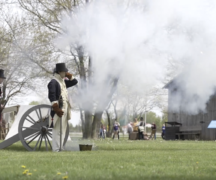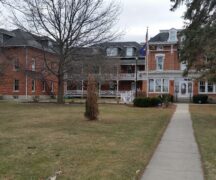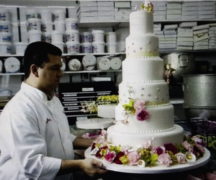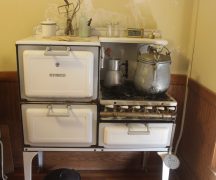By JAN LARSON McLAUGHLIN
BG Independent News
The newest exhibit at the Wood County Museum takes visitors on a whirlwind romance, starting with courtship and ending at the American dream. In between, the exhibit gives visitors a glimpse of local weddings and marriage over the decades.
The “Allure and Illusion: A Rose Colored Romance” exhibit opens on Friday, April 8.
A highlight includes 41 wedding dresses worn by Wood County brides – the oldest dating back to 1855. Each dress is accompanied with a wedding photo and information on the couple, from their descendants or the couple themselves.
The exhibit begins with romance – Harlequin romance to be exact. Cover illustrations from the novels show swooning women in the arms of strong men, with titles like “Road to Love,” “Chain of Destiny” and “Outback Bride.” The illustrations are on loan from the BGSU Browne Popular Culture Library.

For those who lift their noses at “bodice rippers for bored housewives,” the display notes that 51% of readers who sneak time with romance novels feel as if they should keep their habit secret. All bets were off, however, when the pandemic hit. In the first year of COVID, 47 million romance novels and eBooks were sold.
Free romance novels are available for museum visitors who wish to take a bit of romance home with them.
After the romance comes the wedding.
“People meet, fall in love and get engaged,” explained Holly Kirkendall, curator at the Wood County Museum.
So the next step is finding the perfect dress. In most cases, the dresses on exhibit were homemade. “These were practical farm wives,” Kirkendall said.
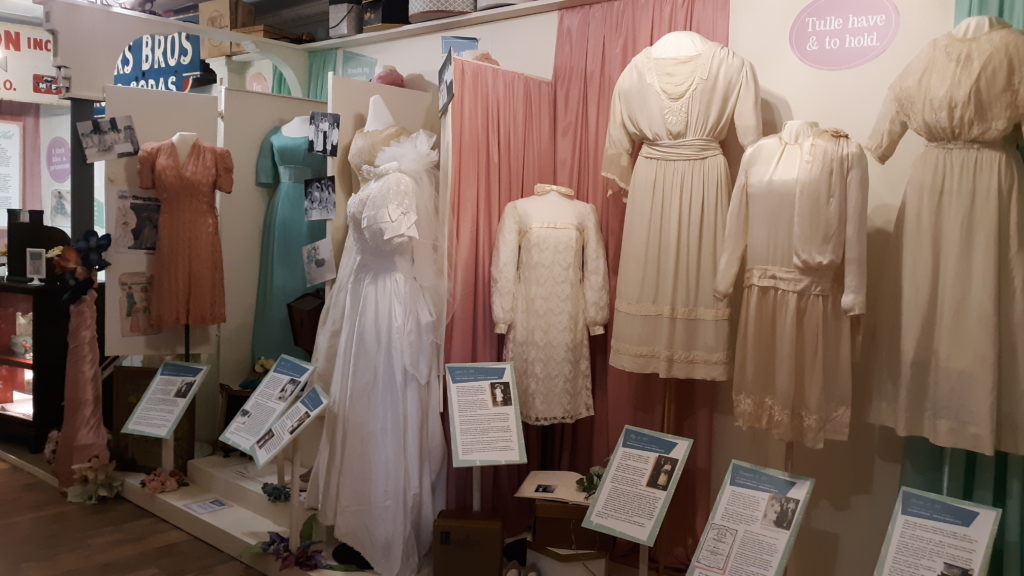
The gowns stretch from the oldest blue satin dress worn in 1855, to a formal white gown from 2001.
“We are celebrating the dresses,” and the couples whose lives changed on the day they were worn, Kirkendall said.
The stories accompanying the gowns tell of couples like Elva Lynn Burrell and Eugene Kirian, who married on Aug. 11, 1956. Their romance began while Eugene was cruising with a group of friends, and tooted their horn at a group of girls. Eugene and Elva ended up going to a square dance together.
And Carol Jean Kaprowski and Robert E. Warnimont who wed on Oct. 1, 1966. The couple met in 1961 at a Halloween party held at a Catholic church in Rossford. The rivalry between Rossford and Perrysburg schools prevented people from dating, “but Robert was extra charming,” Carol recalled.
And Janet Sheperd and Gerald Markin who married on Aug. 4, 1962. The couple met at Pines Roller Rink Street in Bowling Green in 1962 when Gerald was home on leave from serving in the Army in Vietnam. “I flirted with Gerald and asked him to skate the ladies choice,” Janet shared.
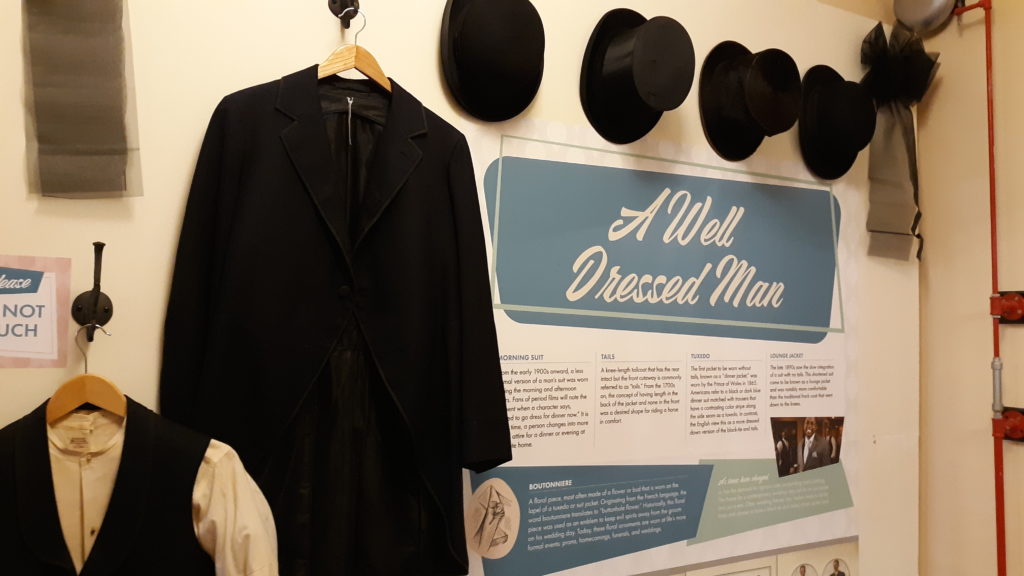
A small section of the exhibit includes the grooms’ wedding wear. “It’s a nod to men’s fashion,” said Marissa Muniz, the museum marketing and events coordinator.
The exhibit isn’t all frills and lace.
There are also some facts and figures. For example:
- Love can come with quite a price tag. The average cost of a U.S. wedding in 2020 was $20,300. In Ohio, the average total wedding cost was $17,899, with $271 spent per guest. Americans spent an average of $50 billion on wedding ceremonies each year between 2015 and 2020.
- The first recorded marriage in Wood County was on Sept. 24, 1820. The first African American couple married in the county on Dec. 31, 1894. And the first same sex couple married in the county on June 26, 2015.
- In 1880, the marital age of consent in Ohio for girls was 10 years old. In 1920, the marital age of consent went to 16 years old. In 2018, the age of consent was raised to 18 for boys and girls.
- In 1925, Bowling Green became a “marriage mill town,” with no waiting period for a marriage license.
- On Sept. 25, 1937, labor union leader Jimmy Hoffa married Josephine Poszywak in Bowling Green.

The Romantic Era occurred between 1770 and 1830, the exhibit explains. While many people wanted to marry for love, the necessity for financial, social and political gain, especially for women, prompted many marriages to be arranged for security over love.
Once married, men worked outside the home for money, and women managed household duties and childcare.
The foundation of American and English marital law dates back to the 1750s: “By marriage, the husband and wife are one person in law, that is, the very being of legal existence of the woman is suspended during the marriage, or at least incorporated and consolidated into that of the husband, under whose wing, protection, and cover, she performs everything.”
As women gained their voices and political status in society over the last century, a major shift from male-dominant rhetoric to women making decisions to marry later in life or not get married at all is becoming more common in today’s culture, Kirkendall pointed out.
“The institution of marriage is changing,” she said.

The exhibit also addresses the “American dream” – the next step after walking down the aisle.
After WWII ended in 1945, soldiers returned home to a different American dream. White collar workers outnumbered blue collar, yet labor unions were strong, helping to build a financially stable middle class.
The formation of the middle class in 1950s America changed the meaning of the “American Dream” from morality and virtue to the affordability and consumption of material goods, including home ownership, Kirkendall said.
But today, the American dream of homeownership is not within reach for many, she added. Social awareness has prompted much debate on the affordability of homes for younger generations.
The “Allure and Illusion: A Rose Colored Romance” exhibit is hoped to attract the customary visitors to the museum, plus others who may not be traditional history buffs.
“We want to capture audiences outside the realm of history,” Kirkendall said.
The exhibit opens to the public on Friday, April 8, with a ribbon cutting at 4 p.m. by the Bowling Green Chamber of Commerce followed by a public reception until 6 p.m.
This exhibit was sponsored by Ohio Humanities and made possible with partnerships with BGSU Browne Popular Culture Library, American Frame, Your Perfect Day, Waddington Jewelers, Downtown Deco, BGSU Music Library and Bill Schurk Sound Archives, Edwin and Irma Wolf, the children of LaVerne (Snyder) and Harold Patten, the Wood County Historical Society, and other contributors.
Beginning April 9, the museum will be open for self-guided tours Monday – Friday, 10 a.m. – 4 p.m. and weekends from 1 – 4 p.m. (closed on government holidays). Admission is $7 for adults and $3 for children, with discounts for seniors, students, and military. Historical Society members receive free admission.
The museum, located at 13660 County Home Road in Bowling Green, is handicap accessible and group tours are welcome.


